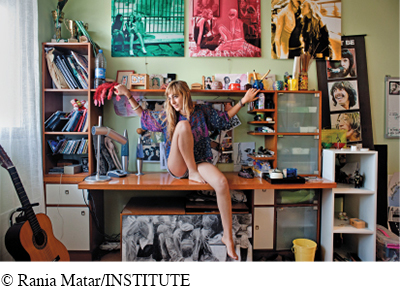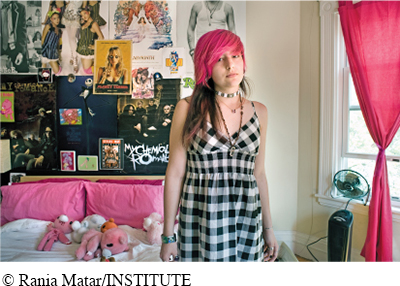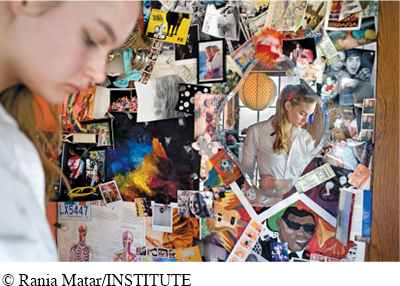5.7
Olds The Possessive
My daughter — as if I
owned her — that girl with the
hair wispy as a frayed bellpull
has been to the barber, that knife grinder,
5 and had the edge of her hair sharpened.
Each strand now cuts
both ways. The blade of new bangs
hangs over her red-
like carbon steel.
10 All the little
spliced ropes are sliced. The curtain of
dark paper-
started from next to nothing in my body —
My body. My daughter. I’ll have to find
15 another word. In her bright helmet
she looks at me as if across a
great distance. Distant fires can be
glimpsed in the resin lights of her eyes:
the watch fires of an enemy, a while before
20 the war starts.
seeing connections
These photographs are part of a collection called A Girl and Her Room by photographer Rania Matar. In her project statement, Matar says, “As a mother of teenage daughters I watch their passage from girlhood into adulthood, fascinated with the transformation taking place, the adult personality taking shape and a gradual self-
How do the images reflect this transformation, and how might the images relate to Olds’s poem “The Possessive”?


Dima, Beirut, Lebanon, 2010


Krystal, Brookline, Massachusetts, 2009


Brianna, Winchester, Massachusetts, 2009
Understanding and Interpreting
The “possessive” is a grammatical term indicating ownership. How is the idea of ownership that is introduced in the title developed further in the poem?
On a literal level, the speaker is describing her daughter’s visit to the barber where she gets a significantly different hairstyle. But, what does the haircut represent metaphorically? And what effect is this change having on the speaker?
In the fifth stanza, the speaker decides that “daughter” is no longer an adequate description and she will have to find “another word” (l. 15). What has led her to decide she needs a different word? What words do you think the speaker might choose to express her new understanding of her relationship with her daughter?
By the final stanza, according to the speaker, the daughter has become an “enemy” who awaits a “war” (ll. 19–
20). In what way is the haircut part of the preparation for this war?
Analyzing Language, Style, and Structure
The speaker begins the poem by considering the phrase “my daughter,” and then dismisses it because it implies ownership. What effect does the speaker’s dismissal of the phrase have on our understanding of her attitude toward her daughter?
In the opening stanza, the speaker reveals that her daughter has just been to the barber for a haircut. She also describes the barber as a “knife grinder,” who sharpens the “edge” of her daughter’s hair (ll. 4–
5). In what ways does this description set up different possible ways of understanding the significance of this event? The phrase “cuts both ways” means that something has two different effects simultaneously, usually one positive and the other negative. What are two possible effects that may be occurring as a result of the daughter’s haircut?
The speaker sees “[d]istant fires” in the “resin lights” (ll. 17–
18) of her daughter’s eyes, continuing the warlike imagery. Describe the tone that these phrases, along with those in the previous stanza, create in the poem as a whole. In your description, try using two adjectives to express the complexity of the speaker’s position.
Connecting, Arguing, and Extending
For a variety of reasons, adolescence is often a difficult time for the relationship between parents and their children. This poem uses extensive imagery of weapons and warfare to describe the changing relationship between the mother and daughter. Explain the ways in which the conflict between parents and children is like warfare and the ways it can be seen in less adversarial terms.
Consider the gender issues raised in this poem and the previous poem, “My Son the Man.” Both are by the same poet, but the speaker response to each child is quite different, in part because of gender differences. Write a comparison analyzing how gender affects the parent-
child relationships in these two poems. Page 158In “The Possessive,” the speaker focuses specifically on her relationship with her daughter and possible conflicts with her daughter in the future. However, researcher Karen Fingerman, PhD, who interviewed adult women about their relationships with their elderly mothers, found that despite conflicts and complicated emotions, the mother-
daughter bond is so strong that 80 percent to 90 percent of women at midlife report good relationships with their mothers— though they wish those relationships were even better. What do you think creates this strong bond between mothers and daughters, even if they experience some conflict earlier in life? Is there something inevitable about conflict between mothers and daughters earlier in life that is then resolved later in life? If so, what are some possible reasons for the changed relationships? 
Emma Watson, the actress who played Hermione in the Harry Potter films, cut her hair immediately after the end of filming the last installment. The haircut became a major media event, and marked a clear departure between the old Emma and the new Emma.
“I have to [grow my hair out] for roles. But if I had it my way, I would have just kept it short forever. Of course, men like long hair. There’s no two ways about it. The majority of the boys around me were like, ‘Why did you do that? That’s such an error.’ And I was like, ‘Well, honestly, I don’t really care what you think!’ I’ve never felt so confident as I did with short hair—
—Glamour Magazine
Similarly, Sharon Olds has taken a simple haircut and elevated its importance in this poem. Is getting a new hairstyle really that significant? Do you think that there are different standards for males and females when it comes to the significance of hair?